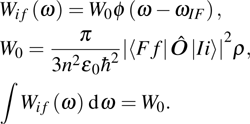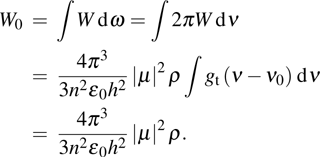3.1. Optical absorption and emissionLet us consider a plane electromagnetic wave, its electric and magnetic vector can be written as
where
μ is the permeability,
ε is the dielectric constant,
n is the refractive index,
c is the light speed in vacuum, and

is the wave vector. In the atomic size region,

,

, the electric field can be seen as a uniform field whose energy density for a linear medium
[5] is
During a period  , the average energy density
, the average energy density
and then the average energy density per unit angle frequency

can be written as
and

should have dimension Hz
−1, which satisfies the relationship

. If the energy is distributed in a finite region near
ω, then

should be replaced by

:
The additional energies  induced by electric and magnetic dipole
induced by electric and magnetic dipole  and
and  in the time-dependent electromagnetic field are
in the time-dependent electromagnetic field are
With Eq. (13), equation (18) is written as
Consider a transition from the initial state 
 with lower energy EI to
with lower energy EI to  (
( with higher energy EF. Where i and f are used to disignate degenerated states, the transition probability caused by the electric or magnetic dipole should be written with respect to angle frequency ω according to Eq. (2.4.7) in Ref. [6]:
with higher energy EF. Where i and f are used to disignate degenerated states, the transition probability caused by the electric or magnetic dipole should be written with respect to angle frequency ω according to Eq. (2.4.7) in Ref. [6]:
where the δ function in the reference has been replaced with a profile function
ϕ,

,

,
h is Planck’s constant,
ε0 is the dielectric constant in vacuum. For randomly oriented dipoles, mean value

over all dipole orientations is 1/3, so substituting Eq. (
16), (
17), or (
19) into Eq. (
20) gives
with

for the electric dipole and

for the magnetic dipole. Equation (
21a) implies the following equations:
For convenient comparison, we can substitute Eq. (2c) into Eq. (21a), yielding
which corresponds to Eq. (2.4.30) in Ref. [
6]
It can be seen that the right side of either Eq. (21a) or (21b) is equal to that of Eq. (21c), but all of them should be integrated versus ω in order to obtain the total transition probability
If we want to know the total value W0 of W by integrating (21c) versus ν directly on both sides, W should be written as
In fact, this has been proved in Section 2; the factor  is from the condition that equation (21c) should be integrated against ω, even though it contains the profile function
is from the condition that equation (21c) should be integrated against ω, even though it contains the profile function  . Furthermore, there exists a difference of a factor of
. Furthermore, there exists a difference of a factor of  in the absorption probability formulae (24a)–(24d), (28), and emission probability formulae (30a)–(30c) in the following contexts.
in the absorption probability formulae (24a)–(24d), (28), and emission probability formulae (30a)–(30c) in the following contexts.
Consider that the local electric field correction  for the electric dipole transition should be multiplied by a correct factor
for the electric dipole transition should be multiplied by a correct factor  in Eqs. (21a)–(21c). According to Eqs. (17) and (19) in Ref. [7], for an electron in a cubic insulator lattice site with relative permittivity
in Eqs. (21a)–(21c). According to Eqs. (17) and (19) in Ref. [7], for an electron in a cubic insulator lattice site with relative permittivity  ,
,  should be
should be
Then the average transition rate WIF of  is
is
Furthermore, n is separated from  to form a medium correction coefficient for the magnetic dipole transition, and equation (24a) is written as
to form a medium correction coefficient for the magnetic dipole transition, and equation (24a) is written as
where

is the Bohr magneton,
e and
m are the charge and mass of an electron,
ℏ is Planck’s constant divided by 2
π, and

and

are the orbital and spin momentum operators. According to the conclusion in Section
2,
WIF can be written in terms of frequency or wavelength immediately as
where

. Consider the relationship
and the Einstein relation
where
BIF is Einstein’s stimulated absorption coefficient,
AFI is Einstein’s spontaneous emission coefficient,
BFI is Einstein’s stimulated emission coefficient. Then the spontaneous emission transition probability
AIF can be written as
It is usually to call  line strength with dimension
line strength with dimension  , whose value is
, whose value is
3.2. Absorption coefficient and emission cross section3.2.1. Absorption coefficientThe ion number variation rate in EI caused by the stimulated absorption, stimulated and spontaneous emission between  and
and  is given by
is given by
where
NI is the absorption ion center number in the volume passed by light beam per unit time. For a general absorption measurement,

,
Assume a light beam with cross section Λ and intensity  , which is the energy passing through Λ per unit time, passes through a medium by
, which is the energy passing through Λ per unit time, passes through a medium by  and decreases by
and decreases by  per unit time, then
per unit time, then
The absorption coefficient is defined as
Substituting Eqs. (34a)–(34c) into Eq. (35) gives
where
Ni is the absorption ion concentration,
Substituting Eq. (28) into Eq. (36) leads to
According to the conclusion in Section 2, the following equation can be written immediately:

can be measured experimentally and is labeled as

here; then integrate (
37c) against
λ directly, take

as a constant and

for a sharp absorption band; then
Based on Einstein’s relationship and Eq. (38a), AFI can be obtained from the absorption spectrum integral as
3.2.2. Emission cross sectionFor laser operation, spontaneous radiation does not need to be considered, so equation (32) is changed to
Like the absorption coefficient, the emission coefficient or gain coefficient β is defined as
Substitute Eqs. (34b), (40b), (40c) into Eq. (40a),
where
which is the inversion activator number per unit volume. The emission cross section is defined as
Substituting Eq. (28) into Eq. (41) gives
Using Einstein’s relationship Eq. (29),  can be written as
can be written as
Substituting Eqs. (2b) and (2c) into Eq. (41c), we obtain
which is the F–L formula. Note that
λ in Eq. (
41a)–(
41d) is the wavelength in vacuum, and if we want to know the emission cross section integral value

, all of them should be integrated against
ω, giving
which is the amplitude of the emission cross section and can be multiplied by a profile function to give its distribution in frequency, wavelength, or angle frequency space. Comparing (
41e) with Eq. (
2) in Ref. [
8], we find that the integrated emission cross section

is unreasonable:

















































































































































